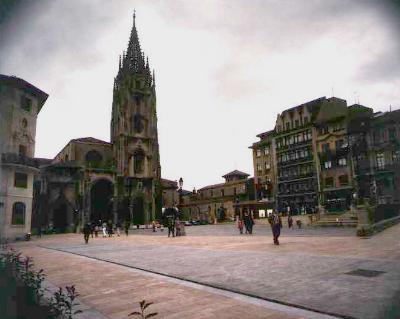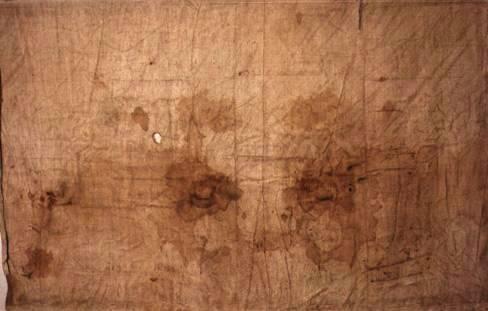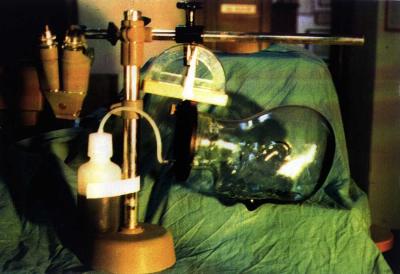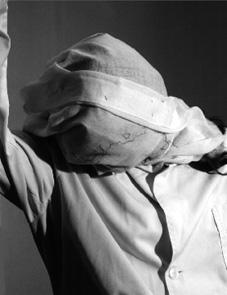1: Physical Description and History
 |
The cathedral in Oviedo where the sudarium is kept
Photo © Luis Montoto and María Mosquera
One of the relics held by the cathedral in the town of Oviedo, in the north of Spain, is a piece of cloth measuring approximately 84 x 53 cm. There is no image on this cloth. Only stains are visible to the naked eye, although more is visible under the microscope. The remarkable thing about this cloth is that both tradition and scientific studies claim that the cloth was used to cover and clean the face of Jesus after the crucifixion. We are going to present and look into these claims.
Such a cloth is known to have existed from the gospel of John, chapter 20, verses 6 and 7. These verses read as follows, "Simon Peter, following him, also came up, went into the tomb, saw the linen cloth lying on the ground, and also the cloth that had been over his head; this was not with the linen cloth but rolled up in a place by itself." John clearly differentiates between this smaller face cloth, the sudarium, and the larger linen that had wrapped the body.
The history of the sudarium is well documented, and much more straightforward than that of the Shroud. Most of the information comes from the twelfth century bishop of Oviedo, Pelagius (or Pelayo), whose historical works are the Book of the Testaments of Oviedo, and the Chronicon Regum Legionensium.
According to this history, the sudarium was in Palestine until shortly before the year 614, when Jerusalem was attacked and conquered by Chosroes II, who was king of Persia from 590 to 628. It was taken away to avoid destruction in the invasion, first to Alexandria by the presbyter Philip, then across the north of Africa when Chosroes conquered Alexandria in 616. The sudarium entered Spain at Cartagena, along with people who were fleeing from the Persians. The bishop of Ecija, Fulgentius, welcomed the refugees and the relics, and surrendered the chest, or ark, to Leandro, bishop of Seville. He took it to Seville, where it spent some years.
 |
The entrance to the Cámara Santa in the cathedral
Photo © Luis Montoto and María Mosquera
Saint Isidore was later bishop of Seville, and teacher of Saint Ildefonso, who was in turn appointed bishop of Toledo. When he left Seville to take up his post there, he took the chest with him. It stayed in Toledo until the year 718. It was then taken further north to avoid destruction at the hands of the Muslims, who conquered the majority of the Iberian peninsula at the beginning of the eighth century. It was first kept in a cave that is now called Monsacro, ten kilometres from Oviedo. King Alfonso II had a special chapel built for the chest, called the "Cámara Santa", later incorporated into the cathedral.
The key date in the history of the sudarium is the 14th March 1075, when the chest was officially opened in the presence of King Alfonso VI, his sister Doña Urraca, and Rodrigo Díaz de Vivar, better known as El Cid. A list was made of the relics that were in the chest, and which included the sudarium. In the year 1113, the chest was covered with silver plating, on which there is an inscription inviting all Christians to venerate this relic which contains the holy blood. The sudarium has been kept in the cathedral at Oviedo ever since.
2: Analysis of the Sudarium
 |
The sudarium of Oviedo
Photo © Jorge Manuel Rodríguez & the Centro Español de Sindonología
All the credit for the investigations carried out on the sudarium must go to the Investigation Team of the Spanish Centre for Sindonology, under the leadership of Guillermo Heras. The medical part of the investigation was done by Dr. José Villalaín.
The stains on the sudarium show that when the cloth was placed on the dead man's face, it was folded over, although not in the middle. Counting both sides of the cloth, there is therefore a fourfold stain in a logical order of decreasing intensity.
From the composition of the main stains, it is evident that the man whose face the sudarium covered died in an upright position. The stains consist of one part blood and six parts fluid from a pleural oedema. This liquid collects in the lungs when a crucified person dies of asphyxiation, and if the body subsequently suffers jolting movements, can come out through the nostrils. These are in fact the main stains visible on the sudarium.
These stains in the nasal area are also superimposed on each other, with the different outlines clearly visible. This means that the first stain had already dried when the second stain was formed, and so on.
 |
The specially modeled head used by Dr. Villalaín to recreate the stains
Photo © Jorge Manuel Rodríguez & the Centro Español de Sindonología
Dr. Villalaín had a specially modelled head made to reconstruct the process of staining and drying, and was thus able to calculate the time that elapsed between the formation of each stain.
The cloth was not wrapped entirely round the head because the right cheek was almost touching the right shoulder. This suggests that the sudarium was put into place while the body was still on the cross. The second stain was made about an hour later, when the body was taken down. The third stain was made when the body was lifted from the ground about forty five minutes later. The body was lying at the foot of the cross for about forty-five minutes before being buried. The marks (not fingerprints) of the fingers that held the cloth to the nose are also visible.
 |
How the sudarium was wrapped around the head
Photo © Jorge Manuel Rodríguez & the Centro Español de Sindonología
The experiments with the model head and the study of the stains also show that when the man died his head was tilted seventy degrees forward and twenty degrees to the right. This position further suggests that the man whose face the sudarium covered died crucified.
There are smaller bloodstains at the side of the main group. It would appear that the sudarium was pinned to the back of the dead man's head, and that these spots of blood were from small sharp objects, which would logically be the thorns that caused this type of injury all over Jesus' head.
The medical studies are not the only ones that have been carried out on the sudarium. Dr. Max Frei analysed pollen samples taken from the cloth, and found species typical of Oviedo, Toledo, North Africa and Jerusalem. This confirms the historical route described earlier. There was nothing relating the cloth to Constantinople, France, Italy or any other country in Europe.
An international congress was held in Oviedo in 1994, where various papers were presented about the sudarium. Dr. Frei's work with pollen was confirmed, and enlarged on. Species of pollen called "quercus caliprimus" were found, both of which are limited to the area of Palestine.
Residues of what is most probably myrrh and aloe have also been discovered, mentioned directly in the gospel of john, 19:39-40, "Nicodemus came as well...and he brought a mixture of myrrh and aloes...They took the body of Jesus and bound it in linen cloths with the spices, following the Jewish burial custom."
The stains were also studied from the point of view of anthropology. The conclusion was that the face that had been in contact with the sudarium had typically Jewish features, a prominent nose and pronounced cheekbones.
Finally, the very fact that the cloth was kept at all is a sign of its authenticity, as it has no artistic or monetary value at all. All the studies carried out so far point in one direction, with nothing to suggest the contrary the sudarium was used to cover the head of the dead body of Jesus of Nazareth from when he was taken down from the cross until he was buried.
3: Coincidence with the Shroud
The sudarium alone has revealed sufficient information to suggest that it was in contact with the face of Jesus after the crucifixion. However, the really fascinating evidence comes to light when this cloth is compared to the Shroud of Turin.
The first and most obvious coincidence is that the blood on both cloths belongs to the same group, namely AB.
The length of the nose through which the pleural oedema fluid came onto the sudarium has been calculated at eight centimetres, just over three inches. This is exactly the same length as the nose on the image of the Shroud.
If the face of the image on the Shroud is placed over the stains on the sudarium, perhaps the most obvious coincidence is the exact fit of the stains with the beard on the face. As the sudarium was used to clean the man's face, it appears that it was simply placed on the face to absorb all the blood, but not used in any kind of wiping movement.
A small stain is also visible proceeding from the right hand side of the man's mouth. This stain is hardly visible on the Shroud, but Dr. John Jackson, using the VP-8 and photo enhancements has confirmed its presence.
The thorn wounds on the nape of the neck also coincide perfectly with the bloodstains on the Shroud.
Dr. Alan Whanger applied the Polarized Image Overlay Technique to the sudarium, comparing it to the image and bloodstains on the Shroud. The frontal stains on the sudarium show seventy points of coincidence with the Shroud, and the rear side shows fifty. The only possible conclusion is that the Oviedo sudarium covered the same face as the Turin Shroud.
4: The Temporal Aspect the sudarium before the Shroud
The sudarium has no image, and none of the facial stains of dried or drying blood visible on the Shroud, especially the stain on the forehead in the shape of an inverted three. The stains on the sudarium were made by a less viscous mixture.
This, together with the fact that the fingers which held the sudarium to Jesus' nose have left their mark, point to a short temporal use of the cloth and eliminate the possibility of its contact with the body after burial.
Jewish tradition demands that if the face of a dead person was in any way disfigured, it should be covered with a cloth to avoid people seeing this unpleasant sight. This would certainly have been the case with Jesus, whose face was covered in blood from the injuries produced by the crown of thorns and swollen from falling and being struck.
It seems that the sudarium was first used before the dead body was taken down from the cross and discarded when it was buried.
This fits in with what we learn from John's gospel, which tells us that the sudarium was rolled up in a place by itself.
5: Conclusions
The studies on the sudarium and the comparison of this cloth with the Shroud are just one of the many branches of science which point to both having covered the dead body of Jesus. The history of the Oviedo cloth is well documented, and the conclusions of this for the dating of the Shroud need no further comment.